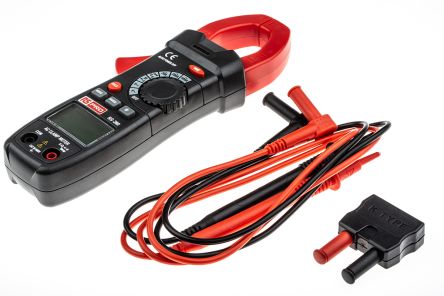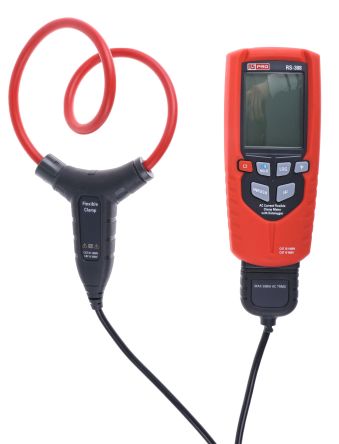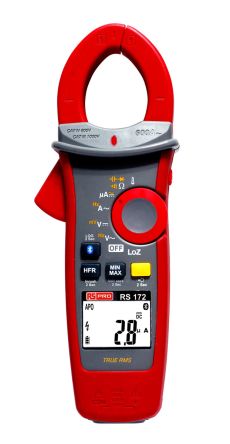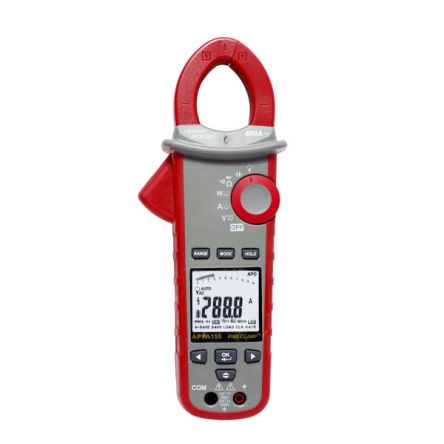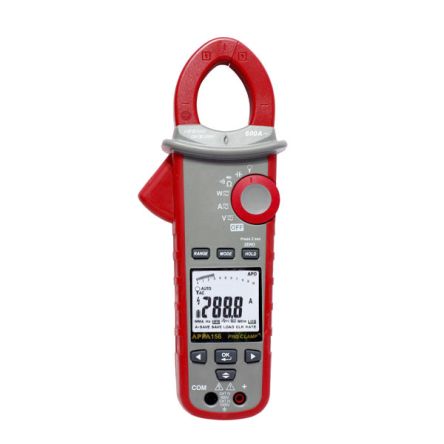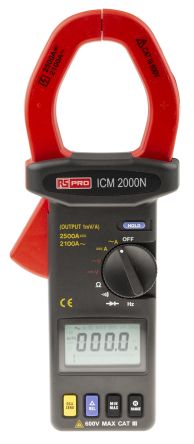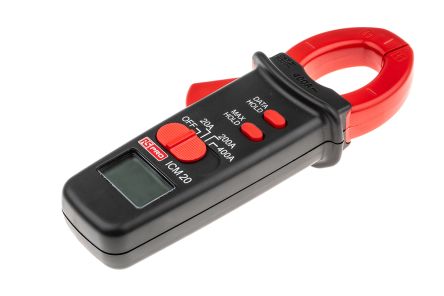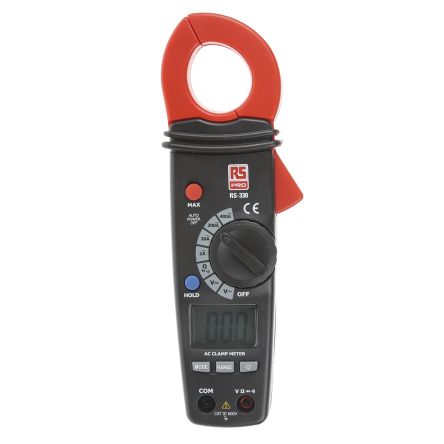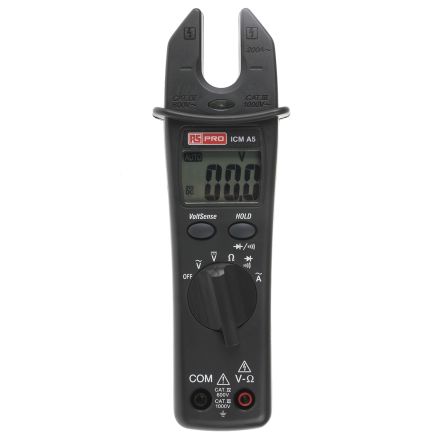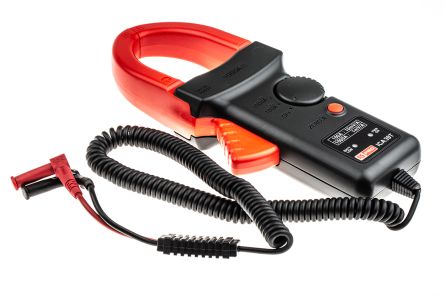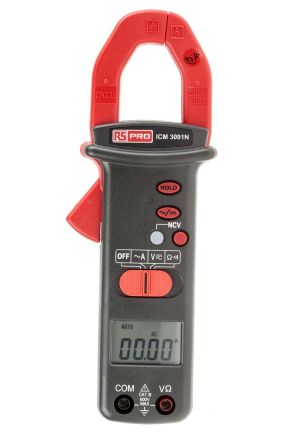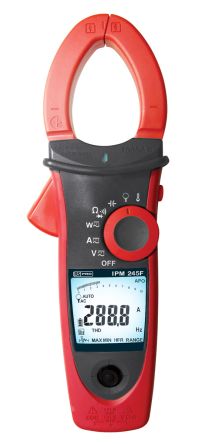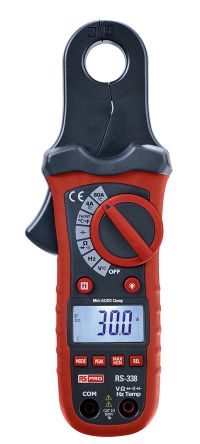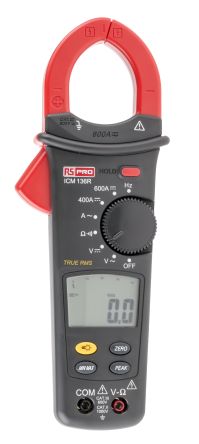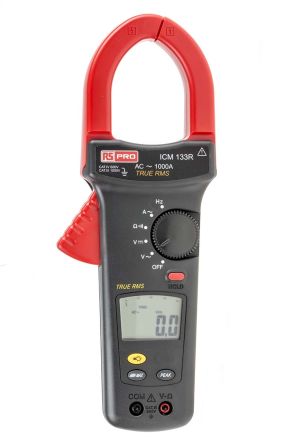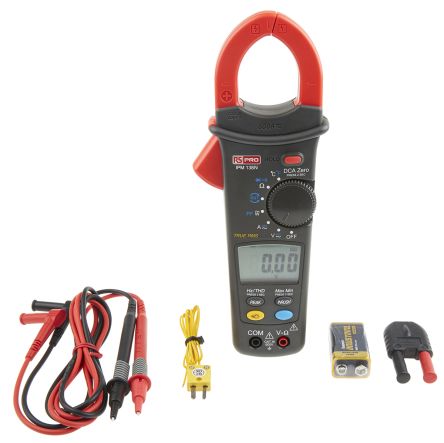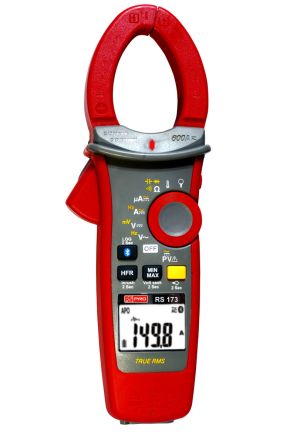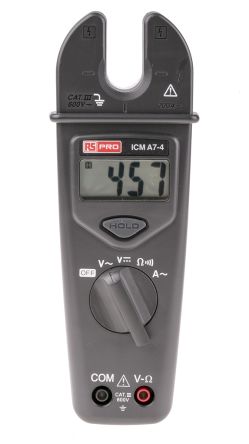- Automation & Control Gear
- Cables & Wires
- Enclosures & Server Racks
- Fuses & Circuit Breakers
- HVAC, Fans & Thermal Management
- Lighting
- Relays & Signal Conditioning
- Switches
- Batteries & Chargers
- Connectors
- Displays & Optoelectronics
- ESD Control, Cleanroom & PCB Prototyping
- Passive Components
- Power Supplies & Transformers
- Raspberry Pi, Arduino, ROCK, STEM Education & Development Tools
- Semiconductors
Clamp Meters
A clamp meter is an essential electrical test tool that combines the functionalities of a basic digital multimeter with a current sensor. These versatile devices are designed to measure various electrical parameters, including alternating current (AC), direct current (DC), AC and DC voltage, resistance, continuity, capacitance, temperature, frequency, and more.
Clamp meters feature a hinged jaw that allows users to clamp around a wire or cable at any point in an electrical system without needing to disconnect it. This non-invasive measurement method enhances safety and convenience, making clamp meters popular among electricians, technicians, engineers, and hobbyists alike. They are particularly valuable for troubleshooting installations, performing maintenance tasks, and ensuring ongoing service requirements.
The Function of Clamp Meters
Originally created as a single-purpose test tool, modern-day clamp meters offer more measurement functions, greater accuracy, and sometimes specialised measurement features. While they retain the basic functions of a digital multimeter, such as the ability to measure voltage, continuity, and resistance, they can now also measure current, capacitance, frequency, and even temperature. This versatility makes clamp meters indispensable tools for electricians, technicians, engineers, and hobbyists alike.
Key Features of Clamp Meters
- Non-Contact Measurement: Clamp meters can measure current without interrupting the circuit, reducing the risk of electrical shocks and arc flashes.
- Multi-Functionality: Recent clamp meter models now include additional input measurements—such as voltage and resistance—making them versatile tools for various electrical tasks.
- Data Logging: Some advanced models may include a data logging function that allow users to record measurements over time for further analysis.
- Wireless Connectivity: Many newer clamp meters offer Bluetooth or Wi-Fi connectivity to transmit data wirelessly to mobile devices or computers for real-time monitoring.
Popular Types of Clamp Meters
Clamp meters come in various types, each designed for specific applications and measurement needs. Here are some of the most common types:
AC Current Meter
AC clamp meters are designed specifically to measure alternating current (AC), which is commonly used in household and industrial power systems. These meters help technicians diagnose issues in AC circuits efficiently.
DC Current Meter
DC clamp meters measure direct current (DC), which is produced by batteries and solar panels. They are often used in electronics and automotive applications where DC measurements are critical.
Flexible Clamp Meters
Flexible clamp meters feature flexible jaws that can wrap around wires and cables in tight or awkward spaces, making them ideal for measuring current in hard-to-reach locations.
Open Jaw Clamp Meter
Open jaw clamp meters have jaws that can be opened and closed around a conductor, allowing for quick and easy current measurements without disconnecting the circuit.
Wireless Clamp Meter
Wireless clamp meters transmit measurement data wirelessly to a separate display unit or mobile device, enabling remote monitoring and data logging.
Frequency Clamp Meter
Frequency clamp meters measure the frequency of AC signals, which is useful for diagnosing problems with power supplies, generators, and motors.
Resistance Clamp Meter
Resistance clamp meters can measure resistance without disconnecting the circuit, making them useful for troubleshooting wiring issues and testing components.
Temperature Clamp Meter
Temperature clamp meters include a temperature sensor, allowing users to measure temperature in addition to electrical parameters, which is useful for HVAC and industrial applications.
Leakage Current Clamp Meter
Leakage current clamp meters are designed to measure small leakage currents, which can be indicative of insulation faults or ground faults, helping to identify potential electrical hazards.
Benefits of Using Clamp Meters
Clamp meters offer a range of advantages that make them indispensable tools for electricians and technicians working with electrical systems. Here are the key benefits of using clamp meters:
- Enhanced Electrical Safety: Non-contact measurements reduce the risk of electrical shocks compared to traditional methods that require cutting into wires or inserting test leads into live circuits.
- Increased Convenience: Digital clamp meters provide quick and easy current measurements without interrupting the circuit, minimising downtime during testing or troubleshooting tasks.
- Versatile Applications: Clamp meters are valuable for a variety of tasks, including servicing existing systems, troubleshooting installations, performing final circuit tests, and supervising apprentices during training.
- Efficient Maintenance: These meters are essential for performing scheduled and preventative maintenance, as well as troubleshooting electrical systems to identify and resolve issues promptly.
- Multi-Functionality: Many modern clamp meters offer additional measurement capabilities beyond current, such as DC or AC voltage, resistance, and continuity, making them versatile tools for various electrical tasks.
Applications of Clamp Meters
Clamp meters are versatile tools used in a wide range of applications across various industries for electrical testing, troubleshooting, and maintenance.
Industrial Applications
Clamp meters are essential in industrial settings, such as:
Motor Control Centres (MCCs)
Clamp meters are frequently used to measure current flow in motor control centres. This allows technicians to diagnose motor overload issues, which can be caused by excessive mechanical load, faulty wiring, or problems within the motor itself.
Power Distribution Systems
Clamp meters play a crucial role in maintaining the integrity and efficiency of power distribution systems. They enable technicians to measure current flow in different branches and circuits, helping to identify imbalances, overloads, and potential faults that could lead to power outages or equipment damage.
Solar Power Systems
Clamp meters are used to measure the DC current output from solar panels, allowing technicians to assess the performance of the panels and identify any issues that may be affecting their performance. Clamp meters also help monitor the performance of inverters, which convert DC power to AC power, ensuring optimal energy conversion and system performance.
Electronic Circuit Testing
Clamp meters with DC current measurement capabilities are invaluable for testing and troubleshooting electronic circuits. They allow technicians to measure the current draw of individual components, identify faulty components that are drawing excessive current, and diagnose various electrical issues within electronic devices.
Electrical Troubleshooting and Maintenance
Clamp meters are indispensable tools for electricians and technicians to perform:
Current Measurement
One of the primary applications of clamp meters is measuring current flow in wires and cables without interrupting the circuit. This non-contact measurement method is safer than traditional methods that require cutting into wires or inserting test leads into live circuits.
Voltage Measurement
Many modern clamp meters also include voltage measurement capabilities. This allows technicians to check voltage levels at various points in a circuit, identify voltage drops that may indicate wiring problems or excessive resistance, and diagnose power supply issues.
Resistance Measurement
Resistance measurement is another useful feature found in some clamp meters. This function enables technicians to check the integrity of wiring, identify faulty connections, and test components like resistors and heating elements.
Frequency Measurement
Clamp meters equipped with frequency measurement capabilities are valuable for diagnosing issues with AC power supplies, generators, and inverters. They can also be used to troubleshoot variable frequency drives (VFDs), which are commonly used in industrial applications to control motor speeds.
Commercial/Industrial HVAC
Clamp meters are valuable tools for technicians working on HVAC systems in commercial and industrial buildings, helping to conduct:
Motor Current Measurement
In HVAC systems, clamp meters are frequently used to measure the current draw of motors that power fans, pumps, and compressors. This allows technicians to identify motors that are drawing excessive current, which could indicate an overload condition, mechanical problems, or faulty wiring.
Voltage Drop Measurement
Voltage drop measurements are essential for identifying issues in HVAC systems. Excessive voltage drop could lead to reduced efficiency, overheating, and premature failure of HVAC equipment. Clamp meters with voltage measurement capabilities enable technicians to quickly identify and address voltage drop issues, ensuring optimal performance and longevity.
How to Choose the Right Clamp Meter
When selecting a clamp meter for your needs, ensure the following:
- Identify Required Measurements: Determine whether you need AC/DC measurements or additional parameters like temperature or frequency.
- Consider Environmental Conditions: Ensure the meter is suitable for your working environment (e.g., IP ratings for high humidity or extreme temperatures).
- Check Accuracy Requirements: Look at specifications regarding accuracy thresholds and margin of error needed for your tasks.
- Evaluate Connectivity Options: Assess if you require wireless connectivity for data transfer.
- Assess Additional Features: Consider features like data logging capabilities if you need long-term monitoring.
The Leading Supplier and Distributor of Clamp Meters
RS Singapore is a trusted supplier and distributor of clamp meters featuring industry-trusted brands like Beha-Amprobe, Chauvin Arnoux, Fluke, FLIR, Keysight Technologies, Megger, RS PRO, and many more. We offer competitive prices and reliable products from top manufacturers to ensure you have the right tools for safe and efficient electrical testing and measurement.
We also carry other essential test and measurement equipment, such as data loggers and digital multimeters, to provide a comprehensive solution for your data monitoring and analysis needs.
Order your leakage current clamp meter, temperature clamp meter, frequency clamp meter, and other accessories online today and enjoy next-day delivery or self-collection at your local branch. For more details on our ordering process, delivery services, and delivery fees, please refer to our Ordering Page and Delivery Page.
Popular Searches
Related links
- Fluke 376 Clamp Meter Max Current 1000A ac CAT III 1000V
- Extech MA1500 Clamp Meter Max Current 1500A ac CAT IV
- FLIR CM276 Clamp Meter Bluetooth Max Current 600A ac
- Amprobe LH41A Clamp Meter Max Current 40A ac CAT III 300 V
- GMC-I Prosys CP410 Clamp Meter Max Current 400A ac CAT III 300V
- RS PRO ICM2000N Clamp Meter Max Current 2100A ac CAT III 600 V
- Extech 380950 Clamp Meter Wireless Max Current 80A ac CAT III 300V
- Ideal Industries 61-757 Clamp Meter Max Current 600A ac CAT III...
